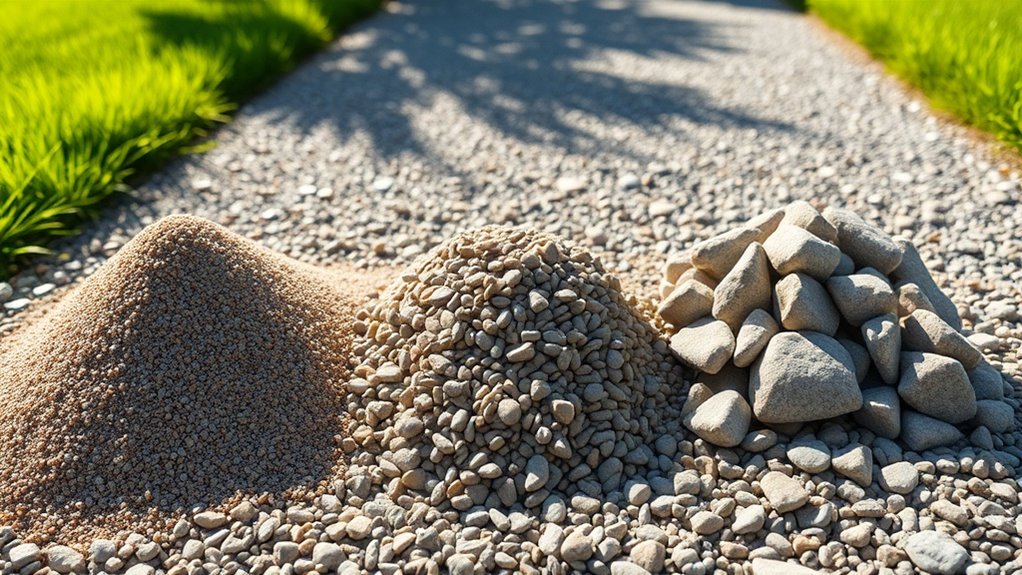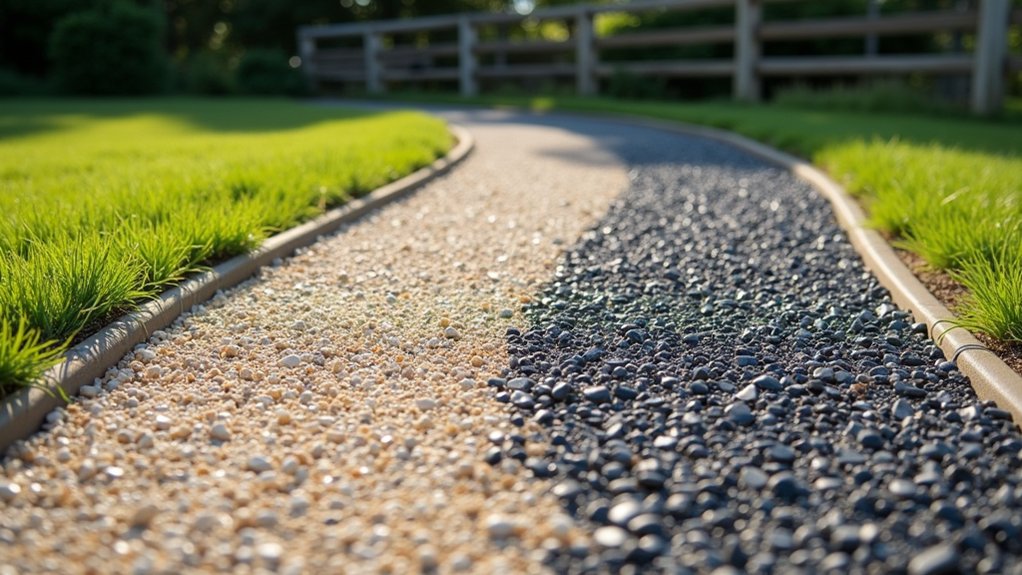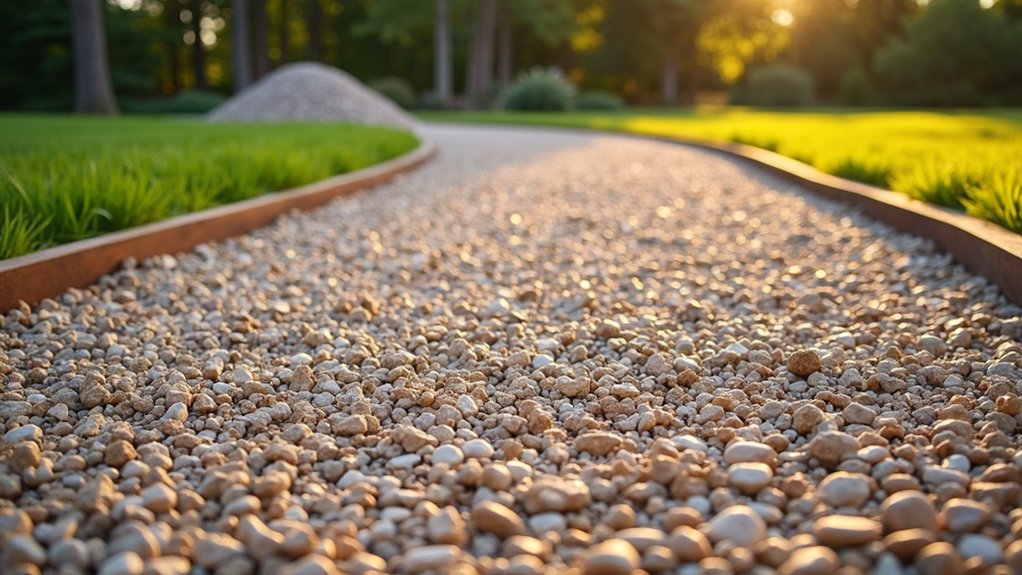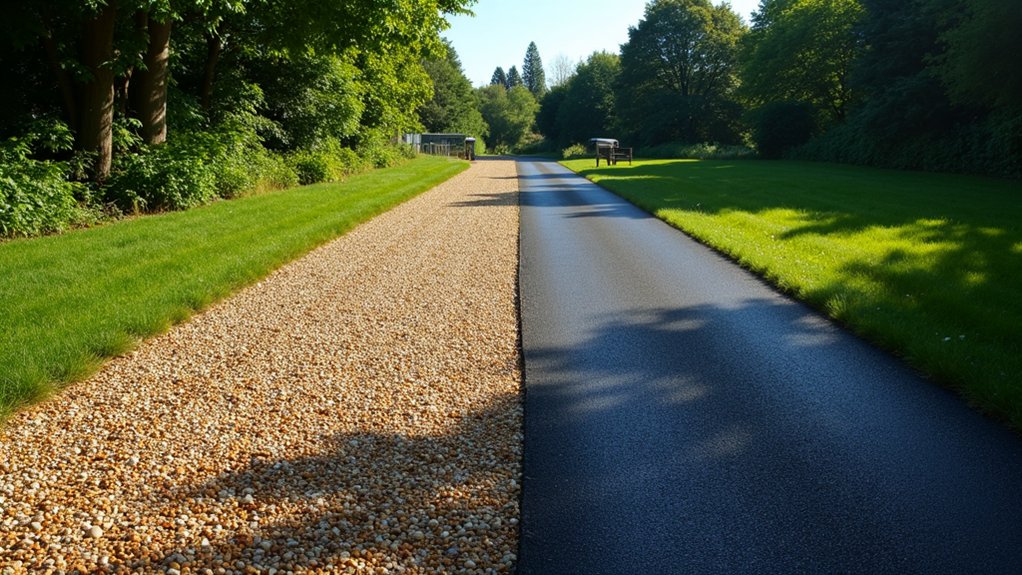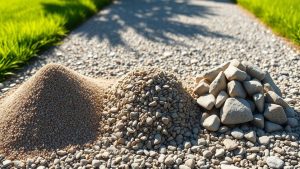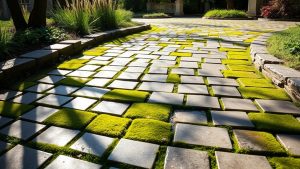The ideal gravel size for a driveway in the UK is usually between 19 mm to 25 mm (3/4 inch to 1 inch) of crushed stone. This size offers great stability and effective drainage. Using angular gravel helps it lock together better, enhancing durability. A layered approach with a robust base of larger stones topped with smaller gravel aids in load distribution and compaction. This setup also encourages efficient drainage and easier maintenance. When planning your driveway, consider different gravel options and look into the best installation techniques for optimal results.
Table of Contents
ToggleKey Takeaways
For a durable driveway, use crushed stone sizes between 19 mm to 25 mm (¾ inch to 1 inch). A solid base layer of large angular stones (crushed stone #3) provides stability and helps prevent settlement issues over time. To improve appearance and interlocking capabilities, add a top layer of smaller gravels (10 mm to 20 mm).
For effective drainage and manageable upkeep, gravel sizes of 12 mm to 38 mm are ideal. If your driveway will see heavy use, consider #1 crushed stone (50 mm to 100 mm) for a robust base that distributes weight well.
Understanding Gravel Sizes for Driveways
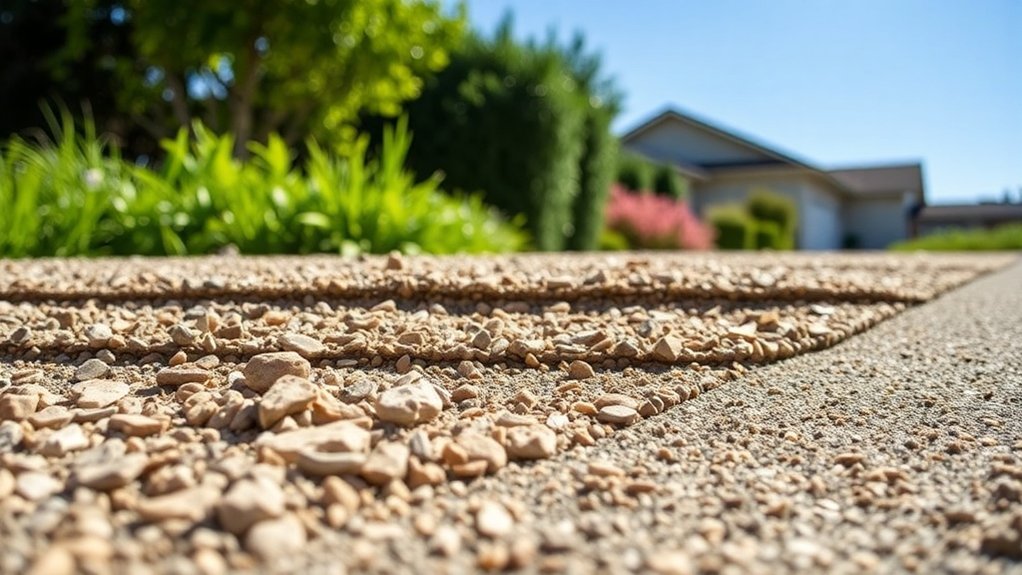
When selecting gravel for your driveway, it’s important to understand the different sizes available to ensure optimal performance and durability.
Gravel is generally classified into fine, medium, and coarse sizes, each serving distinct purposes. For driveways, it’s advisable to use crushed stone ranging from 19 mm to 25 mm (3/4 inch to 1 inch), as it compacts well and provides excellent drainage. Gravel driveways typically require three layers for optimal durability, which further emphasizes the importance of selecting the correct size for each layer. Additionally, using coarse pit run materials can handle heavy loads and improve overall drainage.
Coarse gravel (20–63 mm) boosts load-bearing capacity, helping to prevent rutting and shifting. Smaller options, like pea gravel, can look attractive but may affect stability and drainage.
Angular crushed stone is preferred due to its interlocking properties, which enhance the durability of the surface.
Multi-Layer Gravel Driveway Structure
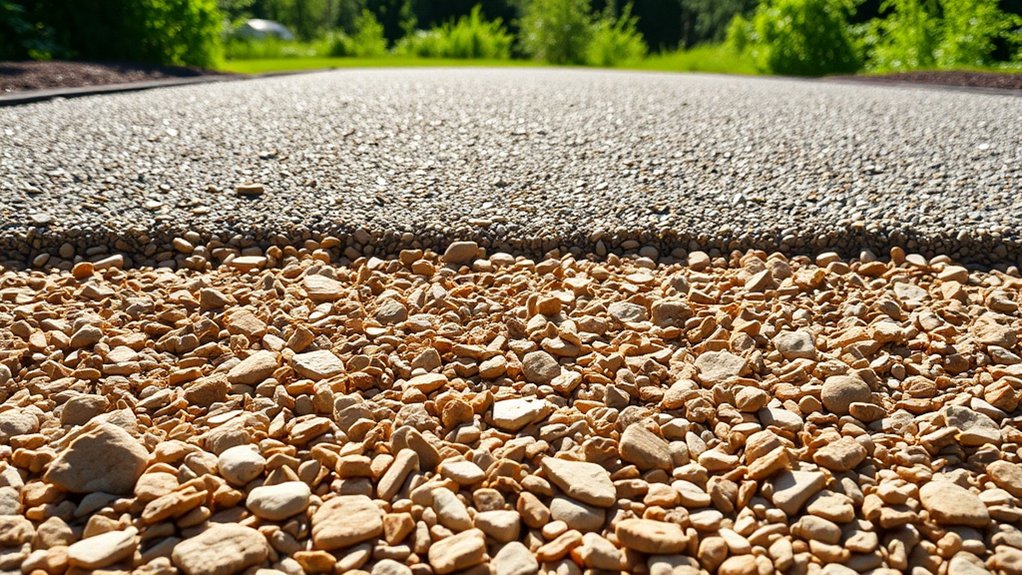
Choosing the right gravel size is just the start; understanding the multi-layer structure of a gravel driveway is crucial for stability and longevity.
Begin with a solid base layer using large angular stones, such as crushed stone #3, compacted in 4-inch lifts to ensure stability. The Proper compaction(proper compaction) is essential for achieving a solid base and preventing erosion over time. Additionally, ensuring a slight slope(slight slope) in the driveway design helps with drainage and water management.
Finally, top it off with smaller gravels, typically between 10mm and 20mm, for a smooth finish.
Incorporate geotextile fabric for separation and ensure proper drainage design to maintain the driveway’s integrity and prevent erosion. This layered approach not only boosts durability but also makes maintenance simpler over time.
The Importance of Gravel Shape and Compaction
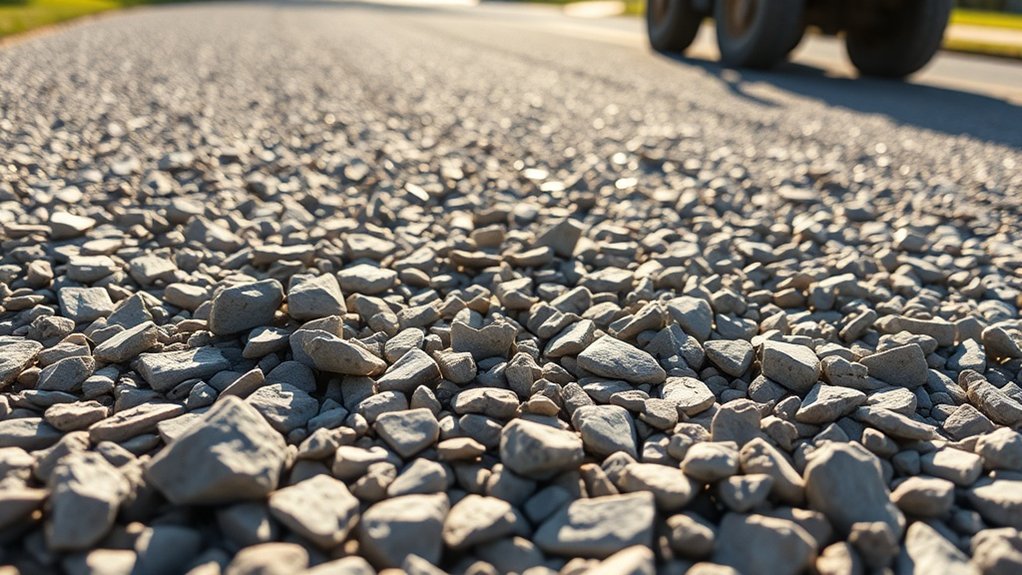
Understanding the shape of gravel and the compaction process is crucial for a stable and durable driveway. Angular gravel pieces lock together tightly, enhancing durability and preventing movement under vehicle weight. This interlocking is essential for effective load distribution. Additionally, proper base preparation is vital, as it ensures that organic soils are removed and replaced with compacted aggregate to prevent future settlement issues. A well-constructed gravel driveway should also incorporate a sub-base to provide stability and prevent sinking over time.
Using proper compaction techniques, such as employing a plate compactor and compacting in layers of 2–4 inches, increases gravel density and reduces settling over time. However, be cautious, as over-compaction can damage the gravel, reducing its effectiveness. Well-graded gravel, which consists of a mix of particle sizes, fills gaps and improves both stability and drainage.
Effects of Gravel Size on Drainage and Maintenance
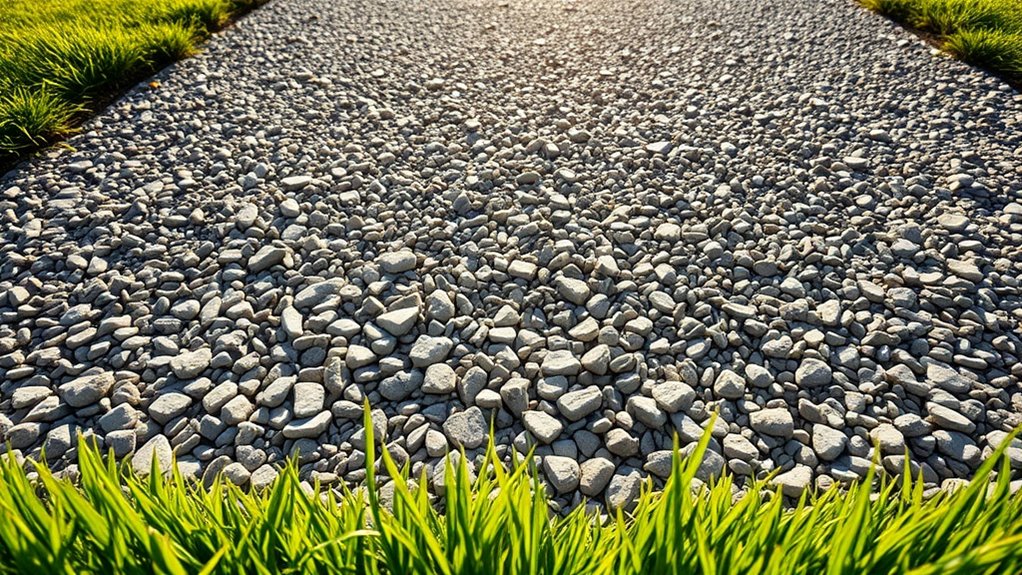
The size of gravel plays a crucial role in drainage and maintenance, making it essential to select the right diameter for optimal performance. Gravel size affects drainage efficiency and erosion, influencing how effectively your driveway handles water flow.
| Gravel Size | Drainage Efficiency | Maintenance Needs |
|---|---|---|
| Smaller than 6mm | Low | High |
| 12mm to 38mm | Ideal | Moderate |
| 38mm and larger | High for heavy loads | Low, but may settle over time |
| 20mm to 40mm | Excellent | Moderate |
| 63mm | Good | Low |
Selecting the right gravel size is key to preventing erosion on steep slopes and ensuring proper drainage across different soil types. Finding the right balance between size and soil conditions is vital for long-term effectiveness.
Choosing Gravel Size for Different Driveway Uses

When selecting gravel size for different types of driveways, it’s important to consider the specific needs of each use for optimal performance.
For residential driveways with light traffic, #57 gravel (about 12mm to 25mm) offers a neat finish, while pea gravel (6mm to 12mm) provides a variety of colours. For a more durable option, choose crusher run material.
For heavy-use commercial or agricultural driveways, #1 crushed stone (50mm to 100mm) creates a strong base, complemented by #3 gravel (25mm to 50mm) for added stability.
This layered approach improves the driveway’s lifespan by evenly distributing weight. Always opt for angular stone types, as they resist shifting under heavy loads, ensuring both functionality and visual appeal.
Frequently Asked Questions
How Do I Calculate the Amount of Gravel Needed for My Driveway?
To calculate the gravel needed for your driveway, start by measuring the length, width, and depth in metres. Multiply these dimensions to find the total volume in cubic metres. Remember to consider both layers for your driveway preparation. It’s wise to order an extra 10% to account for any waste. For instance, if your driveway measures 5m long, 3m wide, and 0.1m deep, you’d calculate: 5 x 3 x 0.1 = 1.5 cubic metres. Then, add 10% for waste, bringing your total to 1.65 cubic metres.
Can I Use Recycled Gravel for My Driveway Installation?
Yes, you can use recycled gravel for your driveway installation. It’s environmentally friendly and cost-effective, derived from construction waste. Recycled gravel offers advantages like better drainage and stability, making it a sensible option for your project.
What Is the Average Cost of Gravel per Ton?
The average cost of gravel per ton in the UK ranges from £8 to £40, depending on current market trends and delivery choices. Buying in bulk can significantly lower costs. Additionally, factors like transport distance and local demand can influence pricing. For instance, if you’re looking to cover a driveway, purchasing a larger quantity at once will save you money in the long run.
How Does Weather Affect My Choice of Gravel Size?
Weather significantly impacts your choice of gravel size. In areas with fluctuating temperatures, larger gravel provides better drainage and stability, making it ideal for wet conditions. Smaller gravel can easily shift when it rains. For better compaction and to minimise erosion in various climates, opt for angular gravel.
Should I Hire a Professional or Do It Myself for Gravel Installation?
Consider the pros and cons of DIY versus hiring a professional for gravel installation. While tackling the project yourself can save money, a professional ensures the job is done correctly, which can minimise long-term maintenance issues. Think about your own skills and the time you can dedicate before making your decision. For example, if you’ve done similar landscaping work before, you might feel confident to proceed on your own. However, if you’re unsure, it might be worth investing in a professional to get a quality finish.
Conclusion
In summary, choosing the right gravel size is crucial for a durable driveway, striking a balance between aesthetics and practicality. Larger, coarse gravel may provide better drainage but can be difficult to walk on, while finer gravel offers a smoother surface but may compact and require more upkeep. By understanding these factors, you can make an informed choice that ensures your driveway looks good and withstands the UK’s weather conditions over time.
Keen to enhance your driveway with the right gravel? Discover the best types and find out which one suits your Read more
How to enhance your gravel driveway's stability and durability? Discover key strategies that can transform your drive into a long-lasting Read more
Uncover the essential differences between gravel driveways and tarmac, and find out which option truly suits your needs best.

